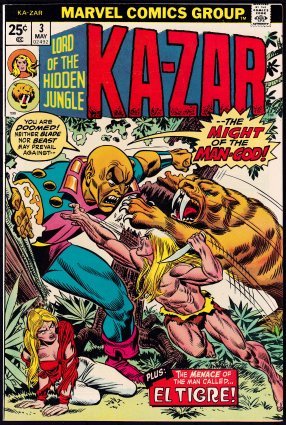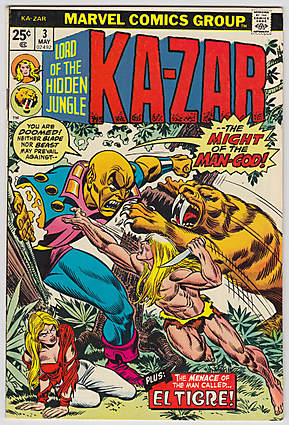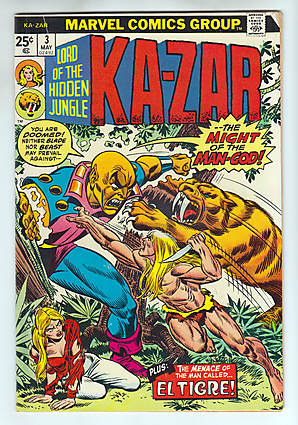KA-ZAR 1974-77 #3
VF/NM: 9.0

(Stock Image)
DESCRIPTION
ow/white pages
(5/74)
Artists Information
Richard "Dick" Ayers was an American comic book artist and cartoonist best known for his work as one of the main inkers during the late-1950's and 1960's Silver Age of Comics, including some of the earliest issues of Marvel Comics' including Jack Kirby's The Fantastic Four. He is the signature penciler of Marvel's World War II comic Sgt. Fury and his Howling Commandos, drawing it for a 10-year run, and he co-created Magazine Enterprises' 1950s Western-horror character the Ghost Rider, a version of which he would draw for Marvel in the 1960s. His career would span 7 decades until his death in 2014.
George Tuska who used a variety of pen names including Carl Larson, was an American comic book and newspaper comic strip artist best known for his 1940s work on various Captain Marvel titles and the crime fiction series Crime Does Not Pay and for his 1960s work illustrating Iron Man and other Marvel Comics characters. He also drew the DC Comics newspaper comic strip The World's Greatest Superheroes from 1978–1982.
Marie Severin was an American comics artist and colorist best known for her work for Marvel Comics and the 1950s' EC Comics. She is an inductee of the Will Eisner Comics Hall of Fame and the Harvey Awards Hall of Fame. Frank Jacobs, in his 1972 biography of EC publisher William M. Gaines, wrote, "There was Marie Severin, Gaines's colorist, and a very moral Catholic, who made her feelings known by coloring dark blue any panel she thought was in bad taste. [EC editor Al] Feldstein called her 'the conscience of EC."'
(5/74)
Artists Information
Richard "Dick" Ayers was an American comic book artist and cartoonist best known for his work as one of the main inkers during the late-1950's and 1960's Silver Age of Comics, including some of the earliest issues of Marvel Comics' including Jack Kirby's The Fantastic Four. He is the signature penciler of Marvel's World War II comic Sgt. Fury and his Howling Commandos, drawing it for a 10-year run, and he co-created Magazine Enterprises' 1950s Western-horror character the Ghost Rider, a version of which he would draw for Marvel in the 1960s. His career would span 7 decades until his death in 2014.
George Tuska who used a variety of pen names including Carl Larson, was an American comic book and newspaper comic strip artist best known for his 1940s work on various Captain Marvel titles and the crime fiction series Crime Does Not Pay and for his 1960s work illustrating Iron Man and other Marvel Comics characters. He also drew the DC Comics newspaper comic strip The World's Greatest Superheroes from 1978–1982.
Marie Severin was an American comics artist and colorist best known for her work for Marvel Comics and the 1950s' EC Comics. She is an inductee of the Will Eisner Comics Hall of Fame and the Harvey Awards Hall of Fame. Frank Jacobs, in his 1972 biography of EC publisher William M. Gaines, wrote, "There was Marie Severin, Gaines's colorist, and a very moral Catholic, who made her feelings known by coloring dark blue any panel she thought was in bad taste. [EC editor Al] Feldstein called her 'the conscience of EC."'








(5/74)
(5/74)